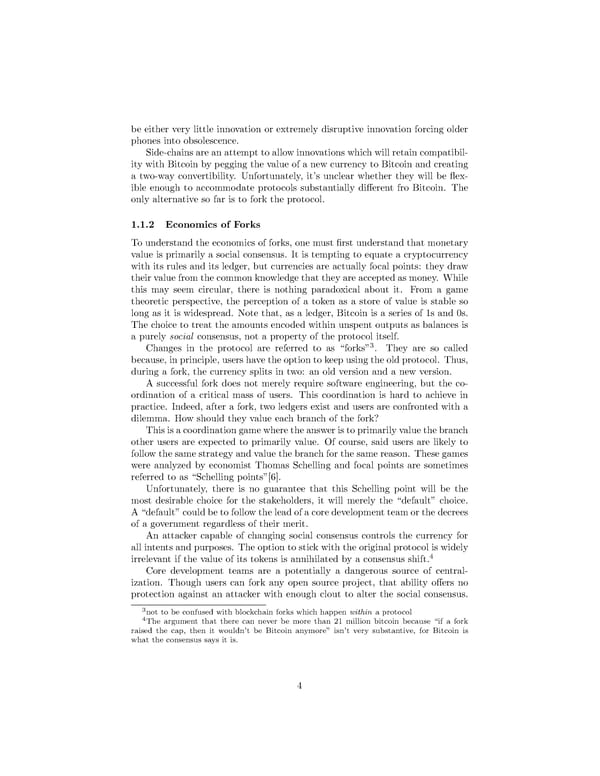be either very little innovation or extremely disruptive innovation forcing older phones into obsolescence. Side-chains are an attempt to allow innovations which will retain compatibil- ity with Bitcoin by pegging the value of a new currency to Bitcoin and creating a two-way convertibility. Unfortunately, it’s unclear whether they will be flex- ible enough to accommodate protocols substantially different fro Bitcoin. The only alternative so far is to fork the protocol. 1.1.2 Economics of Forks To understand the economics of forks, one must first understand that monetary value is primarily a social consensus. It is tempting to equate a cryptocurrency with its rules and its ledger, but currencies are actually focal points: they draw their value from the common knowledge that they are accepted as money. While this may seem circular, there is nothing paradoxical about it. From a game theoretic perspective, the perception of a token as a store of value is stable so long as it is widespread. Note that, as a ledger, Bitcoin is a series of 1s and 0s. The choice to treat the amounts encoded within unspent outputs as balances is a purely social consensus, not a property of the protocol itself. Changes in the protocol are referred to as “forks”3. They are so called because, in principle, users have the option to keep using the old protocol. Thus, during a fork, the currency splits in two: an old version and a new version. Asuccessful fork does not merely require software engineering, but the co- ordination of a critical mass of users. This coordination is hard to achieve in practice. Indeed, after a fork, two ledgers exist and users are confronted with a dilemma. How should they value each branch of the fork? Thisisacoordinationgamewheretheansweristoprimarilyvaluethebranch other users are expected to primarily value. Of course, said users are likely to follow the same strategy and value the branch for the same reason. These games were analyzed by economist Thomas Schelling and focal points are sometimes referred to as “Schelling points”[6]. Unfortunately, there is no guarantee that this Schelling point will be the most desirable choice for the stakeholders, it will merely the “default” choice. A“default”couldbetofollowtheleadofacoredevelopmentteamorthedecrees of a government regardless of their merit. An attacker capable of changing social consensus controls the currency for all intents and purposes. The option to stick with the original protocol is widely 4 irrelevant if the value of its tokens is annihilated by a consensus shift. Core development teams are a potentially a dangerous source of central- ization. Though users can fork any open source project, that ability offers no protection against an attacker with enough clout to alter the social consensus. 3not to be confused with blockchain forks which happen within a protocol 4The argument that there can never be more than 21 million bitcoin because “if a fork raised the cap, then it wouldn’t be Bitcoin anymore” isn’t very substantive, for Bitcoin is what the consensus says it is. 4
 A Self-Amending Crypto-Ledger Position Paper Page 5 Page 7
A Self-Amending Crypto-Ledger Position Paper Page 5 Page 7